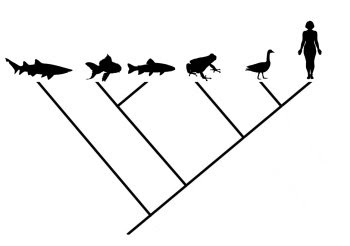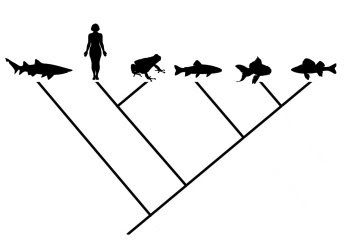In my previous post, written in response to a more egregious fallacy about evolutionary trees presented in a science news story, I focused on the misconception that an “early branching” lineage was necessarily “primitive” (i.e., very similar to a distant ancestor). This time, I want to discuss something slightly more subtle, but nonetheless important, with regard to interpreting phylogenies. Specifically, I want to note a problem with the very concept of one lineage “branching off from” another lineage.
There can be a tendency to consider evolutionary trees as reflecting a main line with a series of “side branches”. This is especially true when the tree is “unbalanced” (lineages are depicted with uneven amounts of diversity) and “ladderized” (the more diverse branches are placed on the same side of each node). The following is a general unbalanced, right-ladderized tree.

This sort of diagram is often interpreted as implying that there is a “main line” leading from a distant ancestor up through time to species A, and that the lineages now represented by species H, G, F, E, D, C, and B “branched off” from this main line earlier or later, in that order. However, one can just as accurately represent this phylogeny with several of the branch points (nodes) rotated with no effect on the order of branching (topology), as shown in the next figure. A is still closest to B, then C, then D, and so on, just as with the previous representation.
 Looking at the most recent split, between A and B, in this version of the phylogeny, it would not make much sense to argue that one branched off from the lineage of the other — they are both derived from a common ancestor from whom their respective lineages diverged at the same time. Likewise, the lineage leading to H did not branch first off a main lineage leading to A, rather it and the lineage that ended up leading to G and all the other species split into two.
Looking at the most recent split, between A and B, in this version of the phylogeny, it would not make much sense to argue that one branched off from the lineage of the other — they are both derived from a common ancestor from whom their respective lineages diverged at the same time. Likewise, the lineage leading to H did not branch first off a main lineage leading to A, rather it and the lineage that ended up leading to G and all the other species split into two.
Looking at a real example, one can see how the main line fallacy creeps in when interpreting evolutionary trees. Here is a phylogeny showing the relationships among several lineages of vertebrates, namely cartilaginous fishes, some bony fishes, and some tetrapods. It might be tempting to see this as indicating that sharks branched first, then bony fishes, then amphibians, then birds. This, like the abstract trees presented previously, is unbalanced and ladderized. Humans are placed at one end, as they usually are (even though this is an arbitrary decision — birds could just as accurately assume the rightmost position by rotating their shared node). However, notice what happens when we rotate some nodes and change the sampling of species presented in the phylogeny. In this case, sharks, humans, frogs, and bony fishes are included, but the diversity of bony fishes, which make up about half of all vertebrates, is slightly better reflected.
This, like the abstract trees presented previously, is unbalanced and ladderized. Humans are placed at one end, as they usually are (even though this is an arbitrary decision — birds could just as accurately assume the rightmost position by rotating their shared node). However, notice what happens when we rotate some nodes and change the sampling of species presented in the phylogeny. In this case, sharks, humans, frogs, and bony fishes are included, but the diversity of bony fishes, which make up about half of all vertebrates, is slightly better reflected. If one were to interpret the revised phylogeny in the same way as the first one, then one would conclude that sharks branched first from the main line leading to perch, then the lineage leading to humans and frogs, then the lineage represented by trout, then the one represented by goldfish.
If one were to interpret the revised phylogeny in the same way as the first one, then one would conclude that sharks branched first from the main line leading to perch, then the lineage leading to humans and frogs, then the lineage represented by trout, then the one represented by goldfish.
The point here is that one can only talk about which lineages “branched first” when one has a main line in mind from which other lineages can be considered side tracks. In the case of the “earliest branching animals” discussed in the last post, the lineage now represented by ctenophores and the one that ended up including all the other living animal lineages would simply have split from a common ancestor, and at the time it would not have been possible to identify either line as a branch off the other.
________
Images from Gregory TR. 2008. Understanding evolutionary trees. Evolution: Education and Outreach 1: 121-137.

Interesting, I looked at some other blog entries and I see I will have to read much more, I study in this area among others.
Everyone knows that The Main Line is the series of species that leads to house cats. Our ancestors branched from The Main Line several million years ago, but long after the fishes branched off.
You are doing a really good service with these posts (and that paper…). These ideas are maybe the most difficult in biology, and it seems that lots of students and even some PIs don’t grapple with them at all. Even when we do “get it”, it’s so easy to slip into the wrong mode of thinking.
In your acknowledgements, I assume you are referring to this Jonathan Witt,
http://www.biology.uwaterloo.ca/people/witt/index.html
not this one!:
http://www.discovery.org/scripts/viewDB/index.php?command=view&isFellow=true&id=97
Great post by the way. I look forward to reading the article in full.